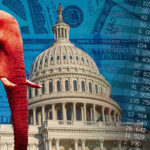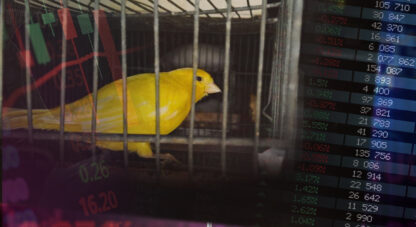Last week from The Institute of International Finance (IIF) (a summary from a members-only report): “Global debt has topped $250 billion – 320% of GDP: emerging market debt hits a new record of $71.4 trillion (220% of GDP); With limited room for further easing, debt service costs will be an increasing constraint on fiscal policy… USD hovering at record highs despite Fed rate cuts this year: persistent growth in demand for U.S. liquidity as dollar debt across EM and mature markets hits record highs. Non-U.S. banks are increasingly reliant on USD funding.”
The IIF estimated that global debt would end the year at $255 TN – “nearly $32,500 for each of the 7.7 billion people on planet” (as noted by Reuters’ Marc Jones). Global debt expanded $7.5 TN during the first half of the year, led by China and the U.S. From Reuters (Marc Jones): “Separate analysis from Bank of America Merrill Lynch… calculated that since the collapse of U.S. investment bank Lehman Brothers, governments have borrowed $30 trillion, companies have taken on $25 trillion, households $9 trillion and banks $2 trillion.”
Looking back, total U.S. Non-Financial Debt expanded 8.16% in 2007, strong growth that few found alarming. It was, after all, down from 2006’s 8.53%, 2005’s 8.77% and 2004’s 9.15%. Conventional thinking had it that the Fed was successfully orchestrating a “soft landing.” Yields were said to remain relatively low in the face of booming Credit demand because of the so-called “global saving glut.”
Financial Sector debt growth at the time was signaling something momentous, though most conventional analysts at the time chose to disregard financial sector expansion (arguing that such analysis would be “double-counting” Credit already included in household, corporate and government sector tabulations). Financial Sector borrowings expanded at a 13.66% pace in 2007, up from 2006’s 10.35% and 2005’s 9.01%.
I have in previous CBBs highlighted the two-year $1.114 TN, or 27%, increase in (Z.1 category) “Fed Funds and Repurchase Agreements” that culminated with a $319 billion jump during Q1 2008. This data series was emblematic of the extreme speculative leveraging that had taken hold during mortgage finance Bubble “Terminal Phase” excess. While conventional retrospective focuses on risky mortgage lending and housing market excess, the epicenter of the Bubble was in “repo” finance and myriad instruments (CDO’s, ABS, special purpose vehicles, derivatives and such) financed directly and indirectly in short-term market-based lending markets. It was the Bubble in speculative leverage that kept mortgage rates low in the face of historic borrowing demand.
The decade-old “global government finance Bubble” has notable differences – as well as clear similarities – to the previous Bubble. I have posited that global sovereign debt and central bank Credit have been the key sources of Bubble excess (as opposed to U.S. mortgage Credit). In general, interest rates (along with market yields) have been held at historically low levels, a dynamic that has trimmed overall rates of debt expansion. This cycle has experienced unprecedented growth in central bank balance sheets that analytically should be viewed similarly to financial sector leveraging from the previous cycle. Moreover, I would argue securities finance and speculative leveraging have evolved from a U.S. phenomenon to now comprise “repo” funding markets spanning the globe – “developed” markets, “developing” and, certainly, the “off-shore financial centers.”
The rapid expansions in global “Non-Bank Financial Institutions” and “off-shore” Credit indicate extreme speculative leveraging (akin to U.S. “repos” in 2007). Overall global Credit continues to outpace GDP growth, this despite historically low market yields that significantly reduce debt service costs. Indeed, the unrelenting rapid expansion of debt (and speculative leveraging) in the face of waning global growth dynamics portends difficult times ahead.
From the Bank for International Settlement’s “Statistical Release: BIS International Banking Statistics at end-June 2019.”
Under the headline, “Lending to [Non-Bank Financial Institutions] (NBFI) Continued to Lead Growth in Cross-Border Claims:” “The BIS locational banking statistics show that global cross-border bank claims rose by $365 billion during the second quarter of 2019, to reach $31 trillion by end-June. Their annual growth rate, which averaged around 0% since the Great Financial Crisis, reached a post-crisis high of 6%… Growth in lending to all major sectors increased. Claims on non-bank financial institutions continued to expand the most rapidly (13% year over year).”
Global cross-border bank claims (lending) surged $1.735 TN during the first half, the strongest six-month growth since pre-crisis Q4 ’07 to Q1 ’08. This compares to first-half growth of $324 billion during 2018 and $341 billion in 2017. Over two years, cross-border bank claims surged $2.520 TN, or 9%, to $30.98 TN. The second quarter’s 13% growth in lending to Non-Bank Financial Institutions was the strongest in the five-year history of the data. Notably, growth accelerated from Q1’s 11.7%, Q4 18’s 8.2% and Q3 18’s 6.4% pace.
BIS: “Reporting banks’ cross-border claims on all major sectors expanded during Q2 2019. The $190 billion expansion in claims on non-banks accounted for more than a half of the overall quarterly increase in global cross-border claims. This, in turn, was mostly driven by claims on non-bank financial institutions (NBFIs include entities such as insurance companies, pension funds, hedge funds and money market funds), which increased by $172 billion, resulting in an annual growth rate of 13%. The majority of this new lending to NBFIs was directed towards a few financial centres, such as the Cayman Islands ($37 billion), the United Kingdom ($34 billion) and Luxembourg ($24 billion).”
The $172 billion increase in lending to Non-Bank Financial Institutions followed Q1’s (record for the series) $468 billion surge, putting first-half growth at $641 billion.
BIS: “The latest increase in lending to NBFIs is part of a longer trend. Over the past five years, cross-border claims on that sector have grown at an average annual pace of 7% (compared with 1% for claims on all sectors), reaching $7 trillion at mid-2019.”
BIS: “Lending to offshore financial centres (OFCs) remained strong. It grew at 6% year over year and stood at $5 trillion as of end-June 2019, mostly to the benefit of NBFIs. Banks reported large increases in their claims on the Cayman Islands (+$45 billion), Jersey (+$9 billion) and Hong Kong SAR (+$8 billion).”
The surge in “offshore financial centers” began in 2013, concurrent with the ramp up of global QE following the European bond crisis. After ending Q2 2013 at $3.5 TN, the “offshore financial centers” over six years surged $1.5 TN, or 43%, to $5.0 TN. I’ll assume this data capture only a segment of bubbling global markets funding financial speculation. I also presume this surge in lending has been instrumental in the global collapse in sovereign yields (in the face of massive issuance) that has fueled broad-based inflation in real and financial assets around the world.
We won’t know all the crazy leverage and derivative strategies spawned during this period until the next big de-risking/deleveraging period. If recent articles pointing to the unwind of hedge fund trades as responsible for a jump in Japanese bond yields are accurate, we can assume at this point virtually everything is levered up. Who would have ever thought of leveraging negative-yielding bonds?
BIS: “…Cross-border lending to borrowers in developing Asia-Pacific rose by $27 billion, bringing the annual growth rate to 4%. Claims on China, up by $25 billion, accounted for almost the whole increase. Those claims have grown from a recent low of $699 billion (at end-March 2016) to $990 billion (at end-June 2019).”
Clearly, the Cayman Islands, the UK and Luxembourg are major sources of cheap finance for the global leveraged speculating community. But I ponder how much speculative finance during this cycle has emanated out of the likes of financial centers Hong Kong and Singapore – and flowed freely into higher-yielding Chinese Credit instruments. After all, the world has never seen such a Bubble in “subprime” Credit. I have argued China is the great global Credit Bubble’s Weak Link. Yet, at this point, perhaps it’s Asian finance more generally. The backdrop is increasingly conducive to heightened currency market instability.
For the Week:
The S&P500 declined 0.3% (up 24.1% y-t-d), and the Dow fell 0.5% (up 19.5%). The Utilities added 0.2% (up 19.1%). The Banks increased 0.7% (up 27.4%), and the Broker/Dealers jumped 2.4% (up 19.2%). The Transports fell 0.8% (up 17.6%). The S&P 400 Midcaps declined 0.7% (up 19.4%), and the small cap Russell 2000 dipped 0.5% (up 17.8%). The Nasdaq100 fell 0.5% (up 30.7%). The Semiconductors dropped 3.0% (up 46.4%). The Biotechs surged 3.4% (up 14.4%). Though bullion declined $7, the HUI gold index increased 0.3% (up 31.3%).
Three-month Treasury bill rates ended the week at 1.545%. Two-year government yields added two bps to 1.63% (down 86bps y-t-d). Five-year T-note yields declined two bps to 1.625% (down 89bps). Ten-year Treasury yields fell six bps to 1.77% (down 91bps). Long bond yields dropped eight bps to 2.22% (down 79bps). Benchmark Fannie Mae MBS yields slipped a basis point to 2.70% (down 79bps).
Greek 10-year yields fell six bps to 1.38% (down 302bps y-t-d). Ten-year Portuguese yields gained three bps to 0.40% (down 132bps). Italian 10-year yields declined five bps to 1.18% (down 156bps). Spain’s 10-year yields dipped three bps to 0.41% (down 101bps). German bund yields declined three bps to negative 0.36% (down 60bps). French yields slipped two bps to negative 0.04% (down 75bps). The French to German 10-year bond spread widened one to 32 bps. U.K. 10-year gilt yields declined two bps to 0.71% (down 57bps). U.K.’s FTSE equities index added 0.3% (up 8.9% y-t-d).
Japan’s Nikkei Equities Index declined 0.8% (up 15.5% y-t-d). Japanese 10-year “JGB” yields dipped a basis point to negative 0.07% (down 8bps y-t-d). France’s CAC40 fell 0.8% (up 24.6%). The German DAX equities index dipped 0.6% (up 24.7%). Spain’s IBEX 35 equities index was little changed (up 8.4%). Italy’s FTSE MIB index fell 1.4% (up 26.9%). EM equities were mixed. Brazil’s Bovespa index rallied 2.0% (up 19.4%), and Mexico’s Bolsa increased 0.3% (up 4.5%). South Korea’s Kospi index sank 2.8% (up 3.0%). India’s Sensex equities index was unchanged (up 11.9%). China’s Shanghai Exchange slipped 0.2% (up 15.7%). Turkey’s Borsa Istanbul National 100 index gained 1.1% (up 16.8%). Russia’s MICEX equities index increased 0.4% (up 24.4%).
Investment-grade bond funds saw inflows of $5.190 billion, and junk bond funds posted inflows of $250 million (from Lipper).
Freddie Mac 30-year fixed mortgage rates dropped nine bps to 3.66% (down 115bps y-o-y). Fifteen-year rates declined five bps to 3.15% (down 109bps). Five-year hybrid ARM rates fell five bps to 3.39% (down 70bps). Bankrate’s survey of jumbo mortgage borrowing costs had 30-year fixed rates down 11 bps to 4.01% (down 69bps).
Federal Reserve Credit last week declined $19.0bn to $3.987 TN, with a ten-week gain of $261bn. Over the past year, Fed Credit contracted $82.7bn, or 2.0%. Fed Credit inflated $1.177 Trillion, or 42%, over the past 367 weeks. Elsewhere, Fed holdings for foreign owners of Treasury, Agency Debt declined $4.9bn last week to $3.416 TN. “Custody holdings” were up $10.4 billion, or 0.3% y-o-y.
M2 (narrow) “money” supply gained $15.9bn last week to a record $15.292 TN. “Narrow money” rose $1.058 TN, or 7.4%, over the past year. For the week, Currency increased $1.1bn. Total Checkable Deposits declined $4.0bn, while Savings Deposits rose $15.7bn. Small Time Deposits slipped $1.1bn. Retail Money Funds gained $4.2bn.
Total money market fund assets dropped $45.9bn to $3.526 TN. Money Funds gained $619bn y-o-y, or 21.3%.
Total Commercial Paper declined $10.0bn to $1.121 TN. CP was up $32bn, or 3.0% year-over-year.
Currency Watch:
November 17 – CNBC (Weizhen Tan): “China is heavily exposed to the U.S. dollar, but now, with the risk of ‘decoupling,’ Beijing is silently diversifying its reserves to reduce its dependence on the world’s largest reserve currency, analysts say. Ongoing trade tensions with the U.S. has ‘increased the risk of a financial decoupling’ between the two largest economies, ANZ Research said in a recent report. The White House reportedly considered some curbs on U.S. investments in China such as delisting Chinese stocks in the U.S. Beijing will therefore manage its risk by diversifying its foreign exchange reserves into other currencies, ANZ predicted, as well as build up its ‘shadow reserves.’”
The U.S. dollar index recovered 0.3% to 98.27 (up 2.2% y-t-d). For the week on the upside, the Japanese yen increased 0.1%, the Swedish krona 0.1%, and the New Zealand dollar 0.1%. On the downside, the South Korean won declined 1.0%, the Mexican peso 1.0%, the Swiss franc 0.8%, the Norwegian krone 0.7%, the Canadian dollar 0.6%, the British pound 0.5%, the Australian dollar 0.5%, the euro 0.3%, the Singapore dollar 0.3%, and the Brazilian real 0.2%. The Chinese renminbi declined 0.43% versus the dollar this week (down 2.27% y-t-d).
Commodities Watch:
The Bloomberg Commodities Index declined 0.5% this week (up 2.3% y-t-d). Spot Gold dipped 0.5% to $1,462 (up 14.0%). Silver jumped 1.2% to $17.147 (up 10.3%). WTI crude added five cents to $57.77 (up 27%). Gasoline jumped 2.4% (up 27%), while Natural Gas declined 0.9% (down 9%). Copper increased 0.3% (up 1%). Wheat jumped 2.5% (up 3%). Corn declined 0.6% (up 1%).
Market Instability Watch:
November 20 – Financial Times (Jennifer Ablan and Joe Rennison): “Bond funds buying the best-quality US corporate debt are set to chalk up one of their three best years on record for inflows in 2019, even as the extra returns on offer have shrunk and some Federal Reserve officials expressed concern over mounting risks. Investors have poured $180bn into US bond funds so far this year, trailing only 2009’s $246bn of inflows and 2017’s $210bn, according to Refinitiv Lipper… The rush into the corporate bond market reflects investors’ ongoing need for yield at a time when interest rates remain at very low levels.”
November 18 – Financial Times (Philip Stafford): “The S&P 500 closed at a record high last Friday, just like it did in the six weeks before that. Despite a lot of political turmoil around the world, prices are drifting gently upwards, and a lot of people expect them to keep doing so. The Vix volatility index — a measure of expected swings in the S&P over the next 30 days — has slumped to 12.78, not far off its lowest levels of the year, and well below its 30-year average of around 19. More significant is that hedge funds seem confident that this tranquil state of affairs will continue. They have gone ‘short’ the Vix in a record 204,000 futures contracts tied to the index…”
November 17 – Financial Times (Tommy Stubbington): “Investors lent €487.5m to Greece’s government last month. When the debt matures after 13 weeks, they will get back slightly less than they paid. The high price raised eyebrows in bond markets. Investors had refused to lend to Greece at any price during the eurozone’s 2009-2015 debt crisis, leading to three sovereign bailouts. Now, they are paying Athens to look after their cash… ‘Greece selling at negative yields is absurd,’ says Mohamed El-Erian… ‘It shows you the extent to which markets are distorted. One by one, things that seemed impossible a few years ago have happened.’”
November 18 – Financial Times (David Tuckwell): “Junk bond exchange traded funds are being short sold in bulk. Almost 40% of the US’s biggest junk bond ETFs available for borrowing are on loan to short sellers, according to… FIS Astec Analytics… Such short selling has raised alarm about the quality of the funds’ holdings. It has also prompted the question of whether junk bond ETFs have design flaws that could wreak havoc if market conditions deteriorate. Junk bond ETFs — which buy bonds with low, or ‘junk’, credit ratings — have surged in popularity thanks to a decade of low interest rates. They hold more than $60bn in assets…”
Trump Administration Watch:
November 19 – Wall Street Journal (William Mauldin and Josh Zumbrun): “Trade talks between the U.S. and China are in danger of hitting an impasse, threatening to derail the Trump administration’s plan for a limited ‘phase-one’ pact this year, according to former administration officials and others following the talks. Both sides remain divided over core issues—including Beijing’s demand for removing tariffs and the U.S.’s insistence on China buying farm products—nearly six weeks after an ‘agreement in principle’ was announced by the White House on Oct. 11. ‘China is going to have to make a deal that I like,’ President Trump said… ‘If we don’t make a deal with China, I’ll just raise the tariffs even higher.’”
November 21 – Bloomberg (Daniel Flatley and Justin Sink): “U.S. President Donald Trump is expected to sign legislation passed by Congress supporting Hong Kong protesters, setting up a confrontation with China that could imperil a long-awaited trade deal between the world’s two largest economies. The bill, approved unanimously by the U.S. Senate on Tuesday, passed the House 417-1 on Wednesday and could go to Trump as soon as Thursday. A person familiar with the matter said Trump planned to sign the bill… The remarkable bipartisan support for a hard-line U.S. stance on China creates one of the toughest economic and foreign policy challenges of Trump’s presidency… China’s foreign ministry urged the U.S. to prevent the legislation from becoming law…”
November 19 – Reuters (David Lawder): “A ‘phase one’ trade deal between the United States and China was supposed to be a limited agreement that would allow leaders from both countries to claim an easy victory while soothing financial markets. But it may morph into something bigger if U.S. President Donald Trump agrees to Beijing’s demands to roll back existing tariffs on Chinese goods, people familiar with the talks say. China’s commerce ministry said this month that removing tariffs imposed during the trade war is an important condition to any deal. The demand has U.S. officials wondering if higher Chinese purchases of U.S. farm goods, promises of improved access to China’s financial services industry, and pledges to protect intellectual property are enough to ask in return.”
November 19 – Bloomberg (Jordan Fabian): “Vice President Mike Pence said… it would be difficult for the U.S. to sign a trade agreement with China if demonstrations in Hong Kong are met with violence. ‘The president’s made it clear it’ll be very hard for us to do a deal with China if there’s any violence or if that matter is not treated properly and humanely,’ Pence said…”
November 18 – CNBC (Kevin Stankiewicz): “Former White House chief economic advisor Gary Cohn said… he believes President Donald Trump will go forward with the Dec. 15 tariffs if the U.S. and China haven’t agreed to a trade deal. ‘I think he thinks that that’s a forcing function and if he keeps blinking, he loses credibility in the Chinese eyes,’ Cohn said…”
November 18 – Reuters (Eric Beech): “U.S. President Donald Trump said he complained to Federal Reserve Chair Jerome Powell about high U.S. interest rates in a meeting they held at the White House… ‘At my meeting with Jay Powell this morning, I protested fact that our Fed Rate is set too high relative to the interest rates of other competitor countries,’ Trump said on Twitter… ‘In fact, our rates should be lower than all others (we are the U.S.). Too strong a Dollar hurting manufacturers & growth!,’ he said.”
November 18 – Reuters (Alexandra Alper): “Top Senate Democrat Chuck Schumer and Republican Senator Tom Cotton… urged the U.S. government to swiftly issue rules to make it harder to export sophisticated technologies to China that Beijing can use to boost its military.”
Federal Reserve Watch:
November 18 – Bloomberg (Christopher Condon): “Federal Reserve Bank of Boston President Eric Rosengren warned his fellow monetary policy makers against putting financial stability at risk in pursuit of higher inflation. ‘I don’t think there’s a big cost to being a little below 2%,’ Rosengren told Bloomberg…, referring to the central bank’s inflation target. ‘I’d rather be higher, but I wouldn’t want to distort financial markets to get that outcome.’”
U.S. Bubble Watch:
November 19 – Wall Street Journal (Daniel Kruger): “Holdings of U.S. government debt by overseas investors declined the most in almost two years in September as yields on Treasurys climbed from near-record lows. Foreign holdings of Treasury debt declined 1.2% to $6.78 trillion, the biggest drop since the end of 2017… Demand for the debt from foreign investors at September’s auctions of new Treasurys was the lowest since before the financial crisis… ‘Foreign ownership of Treasurys hasn’t kept pace with issuance,’ said Jon Hill, a government debt strategist at BMO Capital Markets.”
November 19 – Financial Times (Lucia Mutikani): “U.S. homebuilding rebounded in October and permits for future home construction jumped to a more than 12-year high, pointing to strength in the housing market amid lower mortgage rates… Housing starts increased 3.8% to a seasonally adjusted annual rate of 1.314 million units last month, with single-family construction rising for a fifth straight month and activity in the volatile multi-family sector rebounding solidly… Building permits surged 5.0% to a rate of 1.461 million units in October, the highest level since May 2007. Permits were driven by the single-family housing segment, which increased 3.2% to the highest level since August 2007.”
November 21 – Reuters (Lindsay Dunsmuir): “U.S. home sales increased more than expected in October and house prices rose at the fastest pace in more than two years amid lower mortgage rates and a shortage of properties for sale. …Existing home sales rose 1.9% to a seasonally adjusted annual rate of 5.46 million units last month… Other factors continue to weigh on housing though, including a chronic lack of properties for sale, which has inflated prices and kept many buyers on the sidelines. There were 1.77 million homes in the market last month, a decline of 4.3% compared to a year ago.”
November 19 – CNBC (Diana Olick): “Anyone out shopping for an entry-level home knows the prices are high and the pickings are slim. Now, the same is holding true for rentals. As more Americans find it harder to afford a home, rental demand is soaring, especially for single-family homes. The supply of rental homes is shrinking, and that continues to push rent prices higher, particularly on the lower end of the market. Those less expensive rentals, going for less than 75% of the median regional rent, jumped nearly 4% annually in September, according to CoreLogic. High-end rentals, or those with prices greater than 125% of the region’s median rent, increased just 2.9% annually. ‘Low rental supply coupled with ongoing demand pushed up rents in September,’ said Molly Boesel, principal economist at CoreLogic. ‘Vacancy rates have fallen moderately on the national level over the last quarter – with a 0.3% decrease in the third quarter of 2019 compared to a year earlier – and more significantly in select metro areas.’”
November 21 – Bloomberg (Romy Varghese): “America’s states are increasing their spending at the fastest pace since the end of the Great Recession. Their budgets swelled by 5.9% in the 2019 fiscal year to about $2.1 trillion, the biggest annual increase since the recession ended in 2009, according to… the National Association of State Budget Officers. That’s up from a 3.7% pace in the year before as state officials pumped more money into transportation projects, pensions and reserves that will help them weather the next economic rout.”
November 22 – Wall Street Journal (Matt Wirz): “The default risk of companies owned by private-equity firms is 2.5 times that of their public counterparts, according to data collected from banks, insurers and asset managers by analytics firm Credit Benchmark. Private-equity firms use leveraged loans, rated below investment grade, for the financing of buyouts of target companies. Financial institutions raised their estimates of the average probability of default—or nonpayment—for such loans to about 6% in September from 5.44% a year earlier, according to the data.”
November 19 – Wall Street Journal (Akane Otani and Karen Langley): “Technology stocks are racing toward their best year in a decade… Investors have favored shares of rapidly growing, relatively pricey companies over their more low-valued counterparts for much of the more-than-decadelong bull market. Although the latter group has rebounded over the past three months, technology stocks remain the market’s leaders: The S&P 500 technology sector’s 41% gain for the year has put the group well above the S&P 500’s 24% climb and on course for its biggest one-year advance since 2009.”
November 22 – Bloomberg (Kriti Gupta): “Banks have begun trimming back the credit lines of America’s shale producers, further undercutting a beleaguered industry that’s been struggling to rebuild investor confidence. Laredo Petroleum Inc. and Oasis Petroleum Inc. are among at least six producers whose ability to secure short-term loans against their oil and natural gas reserves have dropped by 10% or more… The declines offer the first hint of results from a semi-annual bank review of the industry’s borrowing capacity that generally runs through December.”
November 22 – Bloomberg (Olivia Rockeman): “The real estate market in downtown Los Angeles is taking a hit as Chinese cash dries up. Condo sales plunged 31% in the third quarter from a year earlier, according to… Miller Samuel Inc. and… Douglas Elliman Real Estate. Chinese buyers have made about 50% of the purchases in downtown Los Angeles in recent years… But tightened restrictions on capital flowing out of China have hampered the market.”
November 21 – CNBC (Hugh Son): “A digital bank that raised $110 million from venture capital funds and celebrities including Leonardo DiCaprio is scrambling to find funding, a potential sign that investors are cooling on risky start-ups after the WeWork debacle. At first blush, Aspiration has all the trappings of a successful disruptor… But Aspiration, which allows its customers to choose how much they pay for services, has so far failed to persuade enough investors to participate in its latest fundraising round, according to people with knowledge of the situation.”
November 20 – Wall Street Journal (Katherine Clarke): “Over a decade ago, Jeff Greene earned a fortune betting against risky mortgages in the last housing market crash. These days, the billionaire is finding himself less lucky in a different real-estate investment—an enormous Los Angeles mansion that he is having trouble selling amid an oversupply of such homes. Mr. Greene said he is planning to once again relist the Beverly Hills home for $129 million, down from its original $195 million asking price when he first listed it in 2014.”
China Watch:
November 22 – Associated Press (Elaine Kurtenbach): “Chinese President Xi Jinping said Friday that Beijing wants to work for a trade deal with the United States but is not afraid to ‘fight back’ to protect its own interests. Echoing the upbeat tone adopted by other Chinese officials in recent days, Xi told a visiting U.S. business delegation that China holds a ‘positive attitude’ toward the trade talks. ‘As we always said we don’t want to start the trade war, but we are not afraid,’ Xi said. ‘When necessary we will fight back but we have been working actively to try not to have a trade war.’”
November 18 – CNBC (Yun Li): “The mood in Beijing about a trade deal is pessimistic due to President Donald Trump’s reluctance to roll back tariffs, which China believed the U.S. had agreed to, a government source told CNBC’s Eunice Yoon. ‘Mood in Beijing about #trade deal is pessimistic, government source tells me. #China troubled after Trump said no tariff rollback. (China thought both had agreed in principle.) Strategy now to talk but wait due to impeachment, US election. Also prioritize China economic support.’”
November 18 – Financial Times (Don Weinland): “China’s central bank cut its short-term lending rate for the first time in four years on Monday, signalling the start of a new easing cycle as Beijing becomes increasingly concerned over slowing economic growth. The People’s Bank of China said… it would lower the seven-day reverse repurchase rate from 2.55% to 2.5%.”
November 19 – Bloomberg: “The People’s Bank of China asked commercial lenders to increase credit support to the country’s economy at a Tuesday meeting, a move aimed at putting a floor under an economic slowdown. The financial sector should ‘put development as the first priority’ while serving the real economy and making sure that economic growth will stay in a reasonable range, the central bank said after meeting with commercial lenders on the current credit situation.”
November 18 – Bloomberg: “Local government investment arms in China were once considered one of the country’s riskiest groups of borrowers and a time bomb in a creaky financial system. But in recent years, a growing number of these heavily-indebted entities, known as local government financial vehicles, have emerged as white knights of a troubled private sector, offering guarantees to loans and bonds from garment makers to construction firms. The shifting role of the LGFVs, which build roads, bridges and airports across China, highlights Beijing’s growing reliance on an ever-bulging state sector to engineer stability in turbulent times. The credit guarantees are part of a broader nationwide campaign to alleviate pain for private businesses hit hard by trade tensions and a weakening economy… Around 2,000 of these funding platforms have offered a total of 5.9 trillion yuan ($842bn) worth of credit guarantees to domestic firms, representing nearly a quarter of their combined net assets, said Liu Yu, an analyst from Guosheng Securities Co.”
November 21 – Bloomberg (Ina Zhou): “Two companies based in China’s Shandong province saw their dollar bonds plunge on Thursday amid signs that their debt troubles are worsening. Shandong Ruyi Technology Group Co.’s dollar bond due in December plunged by 11.2 cents on the dollar to 77 cents…, its biggest drop on record… Shandong Yuhuang Chemical Co., another firm from the same province, saw its dollar bond due in March drop by 13.6 cents to 59 cents, also a record drop for the note…”
November 19 – Bloomberg: “A Chinese bank that backed Tewoo Group Co.’s dollar bond made an interest payment on its behalf, in a sign of worsening finances at the distressed commodities trader. Industrial and Commercial Bank of China Ltd. transferred $7.875 million to repay interest due December 1 on Tewoo’s $500 million dollar bond due 2020… ICBC had provided a standby letter of credit (SBLC) on the note — which is effectively a pledge to repay if the borrower can’t. This is the first such payout since June on an offshore bond from a SBLC provider, when troubled conglomerate China Minsheng Investment Group Corp. received a similar backstop from China Construction Bank Corp.”
November 19 – Bloomberg: “Chinese technology conglomerate Tunghsu Group Co. is looking to extend its bond payment deadlines after failing to settle its obligations this week, in the latest sign that the nation’s private-sector firms are struggling to ease their debt load amid an economic slowdown… Tunghsu Group is in talks with bond investors about extending the repayment deadline on a 7.48% local note, after its Shenzhen-listed unit Tunghsu Optoelectronic Technology failed to repay the 1.97 billion yuan principal and interest.”
November 21 – Financial Times (Sun Yu): “A subsidiary of China’s largest construction group has suspended work on one of the nation’s tallest skyscrapers after the developer became the latest in a string of companies to default on a payment. The default highlights the growing challenges faced by China’s construction groups as the slowing economy trims credit supply, putting the once runaway mega-tower building boom under stress. …China Construction Third Engineering Bureau Co said it would halt construction on a 475m-high skyscraper in the central city of Wuhan. It said Greenland Group, one of the nation’s largest property companies, had failed to make ‘a significant’ project payment.”
November 15 – Bloomberg: “China’s central bank said it will ‘increase counter-cyclical adjustment’ to ward off downward pressure on the economy, while staying vigilant on the possibility of expectations that inflation may spread… ‘It should be noted that the current external environment is complex, the economy is under rising downward pressure, and some businesses are faced with operating difficulties,’ the PBOC said.”
November 17 – Reuters (Cheng Leng and Ryan Woo): “Shares of Harbin Bank, a midsize lender with links to the troubled conglomerate Tomorrow Holdings, rose more than 9% on Monday as state-backed investors became its key shareholders in a $2 billion deal. The bank will now be 48%-controlled by two state-controlled entities… The total transaction will be worth around 15 billion yuan ($2bn)…”
November 19 – Financial Times (Tom Mitchell): “China’s parliament has attacked a Hong Kong court ruling that overturned a contentious mask ban, threatening to inflame tensions in the territory where a police siege of a university has entered its third day. …A National People’s Congress spokesperson said members of its of law and labour committee ‘expressed serious concern’ and ‘strong dissatisfaction’ with the Hong Kong High Court ruling, which invalidated a mask ban implemented in early October.’”
November 17 – Bloomberg (Shawna Kwan): “Home sales in Hong Kong plunged over the weekend as increasingly violent protests shut down parts of the city… The number of transactions in 15 housing estates tracked by Midland Realty International Ltd. slumped 78% on the weekend from a month earlier… ‘The unpredictable social events have intensified in the past few days, affecting apartment visits for potential buyers,’ said Sammy Po, the chief executive officer of Midland’s residential department. ‘Buyers have turned more cautious.’”
Central Banking Watch:
November 22 – Reuters (Balazs Koranyi and Francesco Canepa): “The European Central Bank should not be complacent if its ultra- easy policy fuels bubbles because the tools devised to mitigate these imbalances are in their infancy, Bundesbank President Jens Weidmann said… ‘Monetary policy cannot be complacent if its policy stance raises long-term risks to price stability through the build-up of financial imbalances,’ Weidmann told a… conference. ‘We should not be over-confident about the role macroprudential policy can play in addressing systemic risks,’ he said. ‘This policy approach is still in its infancy.’”
November 19 – Bloomberg (Piotr Skolimowski): “The European Central Bank warned of potential side effects from its loose monetary policy, highlighting how years of unprecedented stimulus designed to bolster the economy is contributing to an erosion of financial stability. Low interest rates have encouraged excessive risk-taking by investment funds and insurers as well as in some real estate markets, the ECB said in its semi-annual Financial Stability Review… ‘While the low interest-rate environment supports the overall economy, we also note an increase in risk-taking which could, in the medium term, create financial-stability challenges,’ Vice President Luis de Guindos said…”
November 16 – Bloomberg (Piotr Skolimowski): “European Central Bank policy maker Madis Muller said the central bank could broadened its asset-purchase program, if the economic situation in the euro area deteriorates significantly. ‘Right now, we are doing unconventional things,’ he told students at a Bundesbank event… ‘You could — of course — imagine even more unconventional things if the situation gets really bad.’”
EM Watch:
November 20 – Bloomberg (Suvashree Ghosh and Rahul Satija): “India’s central bank took control of troubled Dewan Housing Finance Corp. on governance concerns and payment defaults, the second such move at a systemically important shadow lender since 2018. The Reserve Bank of India appointed R. Subramaniakumar, former chief executive officer at state-run lender Indian Overseas Bank as the administrator in the company… Bankruptcy proceedings will be initiated under the country’s insolvency law, the central bank added.”
November 18 – Bloomberg (Divya Patil): “The health of India’s shadow banks remained weak last month as a credit crisis continued to sting. Among four indicators compiled by Bloomberg News covering areas including liquidity and share performance, three were stuck in the same position as the previous month, with two at levels indicating weakness. Another gauge showed total outstanding debt increased at 50 financial firms and other companies impacted by the crisis, as banking-system liquidity remained buoyant given the central bank’s monetary easing.”
November 19 – Financial Times (Henny Sender): “Central bankers around the globe are doing their best to ensure that financial asset prices remain high. But one consequence of keeping interest rates low is that they have left distressed debt funds with few assets to pick up at a sharp discount. At the regional level, capital continues to flow into emerging markets, even those with the gloomiest prospects. India is one of the big beneficiaries of this trend. Debt and stock markets in the country have seen combined inflows of $16bn so far in 2019… Meanwhile, foreign direct investment is up by a fifth… But these positive figures are at odds with a grim mood, particularly in New Delhi, the capital.”
November 19 – Bloomberg (Paul Wallace): “The political crisis in Lebanon has sent yields on some of its dollar bonds into triple digits. Rates on the government’s $1.2 billion of notes maturing in March next year have climbed 28 percentage points this week to 105%. They were at 13% five weeks ago, just before the start of protests that led to the resignation of Prime Minister Saad Hariri and exacerbated the nation’s economic woes. Protesters marched to parliament in Beirut on Tuesday, forcing it to suspend a session as the army and riot police tried to disperse them.”
Europe Watch:
November 20 – Financial Times (Mehreen Khan and Daniel Dombey): “Brussels has warned France and Italy that they are running stubbornly high levels of public debt, meaning their future budgets risk breaching EU rules and alarming investors. The European Commission… published its opinion on the 2020 draft spending plans of all eurozone member states. It had harsh words for Paris, Rome and Madrid which, it said, had failed to make use of good economic times to chip away at their debt burdens.”
November 17 – Reuters (Gavin Jones): “The 5-Star Movement, senior partner in two coalitions since last year’s national election, is struggling with internal strife and falling support which threaten the survival of Italy’s two-month old government. The anti-establishment party won 34% in the March 2018 election, twice that of its nearest rival, but is now polling at half that level. Surveys show a downward trend that is fuelling party anxiety and dissent towards its leader, Luigi Di Maio. Investors are becoming jittery.”
Global Bubble Watch:
November 19 – Bloomberg (Denise Wee): “From Chinese conglomerates to coal miners in Indonesia, companies in Asia are facing rising financial stress, prompting fears defaults will pick up next year. Weaker regional borrowers with dollar bonds yielding at least 15% could come under further pressure next year, when they have about $15.1 billion or nearly a third of such debt due… Amid rising failures in China, some firms are finding it harder to refinance their debt offshore, while Indian shadow lenders are grappling with a liquidity crunch.”
November 17 – Bloomberg (Finbarr Flynn and Annie Lee): “Asian dollar bond sales have jumped to a record of almost $300 billion this year, the kind of unprecedented supply that can start to make investors feel a bit queasy… The market has been red hot this year, with global central banks cutting rates and the hunt for yield accelerating. Issuance in the region excluding Japan is running at $299 billion, the most for similar periods in previous years… The debt has returned the most in five years in 2019, at about 11%.”
November 17 – Financial Times (Jennifer Thompson): “Global dividend growth is expected to falter next year as an economic slowdown across much of the world hurts company profits. In the three months to September this year, total payouts to shareholders grew 2.8% to a record $355.3bn, according to the Janus Henderson Global Dividend Index report. Underlying growth — stripping out the effects of special dividends, currency movements and other one-off factors — was 5.3%.”
Japan Watch:
November 18 – Reuters (Leika Kihara): “Bank of Japan Governor Haruhiko Kuroda… denied ever saying the central bank can deepen negative interest rates unlimitedly, or that it had unlimited ammunition to ramp up stimulus. ‘I’ve never said there are no limits to how much we can deepen negative rates, or that we have unlimited means to ease policy,’ Kuroda told parliament. ‘We need to look not just at the benefits but at the costs in deciding the most appropriate policy step,’ he added.”
November 20 – Financial Times (Leo Lewis): “The Bank of Japan has gone 40 days without making a big purchase of domestic stocks, prompting speculation that it has begun ‘stealth tapering’ the controversial stimulus programme which is soon to enter its tenth year. Analysts and investors in Tokyo have begun to question whether the programme, started in 2010 as a way to prop up the market in the wake of the financial crisis, still serves much purpose. The central bank now owns 80% of the domestic exchange-traded fund market, fanning fears that its grip over prices has become too strong. Under the scheme, the BoJ aims to buy some Y6tn ($55bn) of domestic ETFs every year and has accumulated Y28tn since it began buying in December 2010.”
November 19 – Reuters (Daniel Leussink): “Japan’s exports tumbled at their quickest pace in three years in October, threatening to tip the trade-reliant economy into recession as weakening demand from United States and China darkened the outlook. …Japan’s exports fell 9.2% year-on-year in October, a bigger decline than the 7.6% drop expected by economists in a Reuters poll.”
Fixed-Income Bubble Watch:
November 21 – Bloomberg (Hannah Benjamin and Natalie Harrison): “Money managers are clamoring to buy all the corporate bonds they can in the U.S. and Europe, giving banks a second chance to bring to market deals that were previously scrapped. European high-yield bond sales have reached almost 10 billion euros ($11bn) in November, the busiest month on record… In U.S. high-yield, the market is on pace for its busiest November for bond sales since at least 2005. For U.S. investment-grade sales, issuance this month was on track to be up about 40% from the same period last year…”
November 20 – Reuters (Joshua Franklin): “Many investors are shunning the riskiest corners of the junk-rated U.S. corporate loan market because of concerns about possible credit rating downgrades, putting the brakes on a run of leveraged buyouts and debt-funded dividends. The push back against the riskiest corporate debt shows how the Federal Reserve has failed to alleviate fears about a recession next year that would trigger a cash crunch for heavily indebted companies, corporate financiers and analysts said. Rock-bottom interest rates have fueled a boom in junk rated loans, with the U.S. market tripling in size to $1.3 trillion since 2010 as investors bet on riskier assets, allowing private equity firms to juice their returns and pursue even bigger acquisitions.”
November 18 – Financial Times (Miranda Carr): “Bond bulls should not rest easy. The world may have reconciled itself to the financial insanity of negative yields, as central banks continue to cut interest rates. But there are signs that the big rally in bond prices may be reaching a turning point. The reason? A major, long-term rebalancing in capital flows between the US and China. Instead of excess global capital flowing into overinflated US dollar markets, money is moving into underinvested renminbi assets. China is turning from being one of the largest providers of global capital and a ‘double surplus’ economy — having both a trade surplus and a financial one within its balance of payments — to a consumer of capital… This trend could either significantly tighten global monetary conditions or, more unexpectedly, lead to the imposition of global capital controls. Both scenarios would shake bond markets out of their current complacency.”
November 21 – Bloomberg (Brian Chappatta): “Investors and strategists in the bond markets rarely, if ever, come out firmly against their own asset class. Rather, they opt to use language like ‘be selective,’ ‘move up in credit quality’ or ‘clean up portfolios.’ This is what’s happening now in the once red-hot market for collateralized loan obligations. In October, while U.S. stocks soared to records and high-yield bonds posted their fifth consecutive monthly gain, the pools of leveraged loans quietly faced something of a reckoning. Prices on double-B CLOs tumbled to the lowest in more than three years, according to data from Palmer Square Capital Management.”
Leveraged Speculation Watch:
November 21 – Financial Times (Ortenca Aliaj, Miles Kruppa and Laurence Fletcher): “Louis Bacon, the veteran hedge fund manager, is planning to shut his 30-year-old firm Moore Capital Management and return capital to investors… The decision, which would mark one of the industry’s most high-profile closures to date, follows years of diminished performance and outflows at Moore’s global macro hedge funds… Moore’s assets under management have declined by billions in the past decade to $8.9bn at the end of last year, according to regulatory filings.”
November 19 – Bloomberg (Joanna Ossinger): “Hedge funds are ending the year on a high note as their top picks outperform, according to Goldman Sachs… ‘Hedge fund favorites have rallied sharply so far’ in the fourth quarter after struggling in the prior period, strategists including Ben Snider and David Kostin wrote… Goldman’s list of most-popular hedge fund long positions has outperformed the S&P 500 by 200 basis points since the start of October… The average equity hedge fund is returning 10% year-to-date, they said.”
Geopolitical Watch:
November 20 – Bloomberg: “Former U.S. Secretary of State Henry Kissinger said the U.S. and China were in the ‘foothills of a Cold War,’ and warned that the conflict could be worse than World War I if left to run unconstrained. ‘That makes it, in my view, especially important that a period of relative tension be followed by an explicit effort to understand what the political causes are and a commitment by both sides to try to overcome those,’ Kissinger told a session of the New Economy Forum. ‘It is far from being too late for that, because we are still in the foothills of a cold war.’ Kissinger said China and the U.S. were countries of a magnitude exceeding that of the Soviet Union and America, and that the world’s two largest economies, who are locked in a protracted trade war, ‘are bound to step on each other’s toes all over the world, in the sense of being conscious of the purposes of the other.’”
November 21 – New York Times (Andrew Ross Sorkin): “The United States and China will eventually settle their differences over tariffs — maybe even reach a deal that allows both sides to say they won. But don’t be fooled. Even if the world’s two biggest economies reach a truce, their relationship is likely to get worse. That’s the bold warning that Henry M. Paulson Jr., the former Treasury secretary, plans to make… The danger, Mr. Paulson said, is that the animosity between the two countries has merged ‘military prisms and ideas into economic policies.’ ‘It should concern every one of us who cares about the state of the global economy that the positive-sum metaphors of healthy economic competition are giving way to the zero-sum metaphors of military competition’…”
November 20 – Bloomberg: “China had a swift and forceful response on Wednesday after the U.S. Senate passed legislation supporting Hong Kong’s pro-democracy protesters, with multiple government agencies threatening some sort of unspecified retaliation. ‘Don’t say I didn’t warn you,’ said a statement issued by the foreign ministry’s office…, using a Chinese phrase that prior to this year was used only in rare cases like before a 1962 war with India.”
November 17 – Reuters (Susan Cornwell): “The United States condemned the ‘unjustified use of force’ in Hong Kong and called on Beijing to protect Hong Kong’s freedom, a senior official in President Donald Trump’s administration said Sunday… ‘We condemn the unjustified use of force and urge all sides to refrain from violence and engage in constructive dialogue,’ the senior U.S. official said.”
November 17 – Reuters (Phil Stewart): “China… called on the U.S. military to stop flexing its muscles in the South China Sea and to avoid adding ‘new uncertainties’ over Taiwan, during high-level talks that underscored tension between the world’s two largest economies. The remarks by Chinese Defence Minister Wei Fenghe to U.S. Defense Secretary Mark Esper, recounted by a Chinese spokesman, came just two weeks after a top White House official denounced Chinese ‘intimidation’ in the busy waterway. It also came a day after Esper publicly accused Beijing of ‘increasingly resorting to coercion and intimidation to advance its strategic objectives’ in the region.”
November 17 – Reuters (Lusha Zhang and Cate Cadell): “China will not tolerate any Taiwan independence incidents, a spokesman for its defense ministry said…, urging the United States to deal appropriately with the issue… The defense ministry of self-ruled Taiwan said a Chinese carrier ship passed through the Taiwan Strait on Sunday, tailed by U.S. and Japanese ships. China has never ruled out the use of force to reunite what it regards as a wayward province.”
November 22 – Bloomberg: “In a statement that is likely to annoy some in Japan ahead of his visit planned for next spring, Chinese President Xi Jinping blamed the unpopularity of his country on Japanese bias and prejudice… ‘As for the biased view of Japanese people toward China, yes, China needs to do some things but more importantly the responsibility is on the Japanese side. It needs to do more things to undo the prejudiced and biased views against China.’”
November 21 – Wall Street Journal (John Otis): “Tens of thousands of people marched through the streets of Bogotá and other big cities on Thursday, as the antigovernment protests that have roiled countries in Latin America spread to Colombia. Protesters banged drums and carried Colombian flags and banners, calling for a crackdown on government corruption, higher wages and increased government spending on education. “















